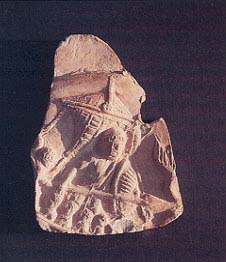Image Details

Lawrence E. Stager, courtesy Leon Levy Expedition
A Mediterranean wanderer. This impression made from a terra-cotta mold found at Ashkelon (see photograph) depicts Odysseus (also known by his Latinized name, Ulysses), the hero of Homer’s Odyssey, battling the sea monster Scylla. Dating to the Roman period (first-second centuries A.D.), the impression shows Odysseus’ spear pointing to the right. The sea monster’s tail whips in front of Odysseus’ face; heads of oarsmen can be seen below the spear and the head of the helmsman can be seen above the spear butt. The Odyssey describes the scene: “I put on my glorious armor and, taking up two long spears in my hands, I stood bestriding the vessel’s foredeck at the prow, for I expected Scylla of the rocks to appear first from that direction.”
The Odyssey is the tale of Odysseus’ ten-year-long trek home from the Trojan War. Greek mythology is filled with tales of heroes wandering the eastern Mediterranean world after the war. Stager observes that these tales, as well as the founding myths of many Near Eastern cities (which claim to have been founded by figures from Aegean lands) contain more than a kernel of truth: He believes, for example, that the land of Canaan was settled by Mycenaean Greeks in the 12th century B.C. As this terra-cotta mold shows, the tale of Odysseus’ wandering was known in Ashkelon as late as the first or second centuries A.D.
